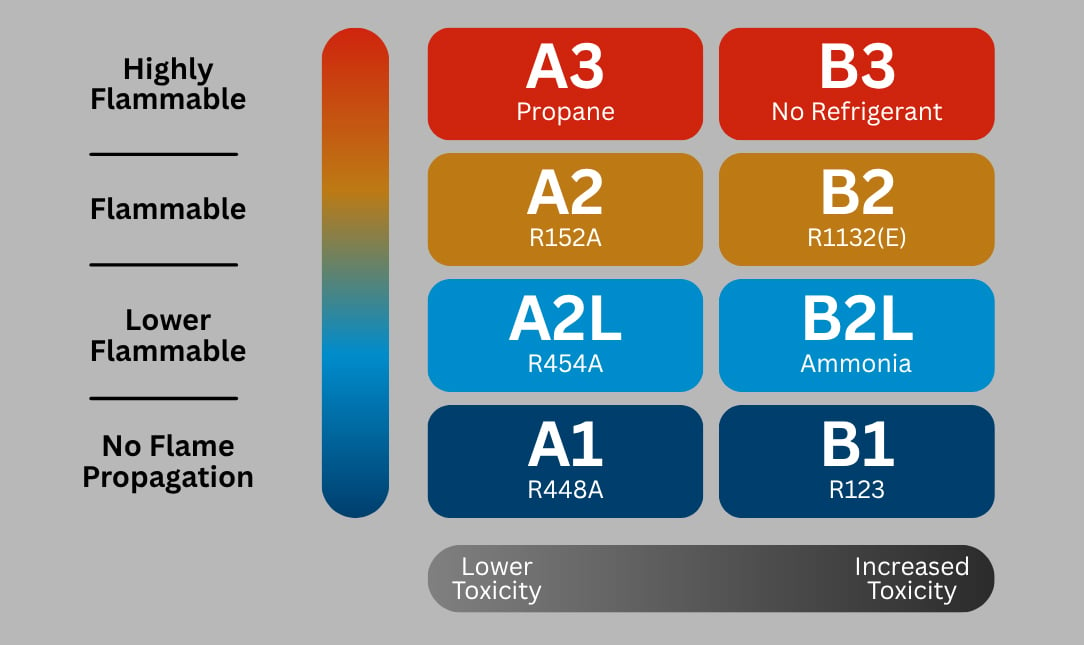Understanding the Switch to A2L Refrigerants
Welcome to the Future of Refrigeration: A2L Compliance Starts Here
The refrigerant landscape is changing fast. By January 1, 2026, all newly installed commercial refrigeration systems in the U.S. must use low-GWP refrigerants under the AIM Act. That means saying goodbye to high-GWP HFCs like R404A and preparing for the next generation of refrigeration: A2L refrigerants.
That's why Thermo-Kool is leading the charge when it comes to helping our customers stay compliant. This page is your complete guide to understanding what A2L refrigerants are, why the change matters, and how Thermo-Kool is building safe, reliable, and regulation-ready walk-in solutions using R454A. Whether you're planning ahead, replacing aging systems, or just beginning to research A2L options, you're in the right place.
Let’s get started.
What Are A2L Refrigerants?
A2L refrigerants are the next generation of cooling agents, and the future of commercial refrigeration. But what exactly does “A2L” mean?
It’s a classification used by ASHRAE to describe refrigerants with low toxicity (that’s the “A”) and low flammability (the “2L”). While they’re not entirely non-flammable like older HFCs such as R404A, A2Ls have a very low burning velocity, making them safe to use when handled correctly and within code.
Why the change? Because traditional refrigerants, despite their reliability, have a high Global Warming Potential (GWP). A2Ls offer a dramatic reduction in environmental impact without sacrificing cooling performance.
To adhere to this compliance, Thermo-Kool has selected R454A as our standard A2L refrigerant. It strikes the right balance between safety, performance, and sustainability, making it ideal for use in our commercial walk-in coolers and freezers.

Refrigerant Flammability Chart
Understanding Cost & ROI
-
Upfront Costs: Expect a 15–40% increase compared to traditional HFC systems due to added safety components like leak detection, ventilation, and A2L-rated parts.
-
Long-Term Savings: Many A2L systems offer 5–10% greater energy efficiency, which can lead to lower utility bills over time.
-
Rebate Potential: Some regions offer incentives or utility rebates for installing energy-efficient, low-GWP systems. Check with your provider.
-
Future-Proofing: Investing now helps avoid compliance issues, fines, or rushed replacements down the road.
.png?width=500&height=221&name=Walk-In%20Full%20(1).png)
What Makes A2L Systems Different?
Switching to A2L refrigerants changes how the entire system is designed and built.
Because A2Ls are mildly flammable, they require additional safety features that weren’t necessary with older, nonflammable refrigerants like R404A. These aren’t optional add-ons. They’re required to meet ASHRAE and UL safety standards.
For example, systems must include leak detection sensors that can automatically trigger ventilation systems to prevent refrigerant buildup in the event of a leak. All electrical components, such as relays, contactors, and controllers, must be A2L-rated to avoid creating ignition risks. In some commercial settings, systems may also require isolation valves or even fire suppression measures depending on the installation environment.
These added layers of protection mean A2L systems are more complex, and in some cases, more expensive, than traditional refrigeration units. But they’re also smarter, safer, and significantly better for the planet.
What Can You Do Now to Prepare for the A2L Switch?
INSTALL
Complete installations of current refrigerant systems before the January 1, 2026 deadline.
SCHEDULE
Schedule training for your team on A2L refrigerants.
PLAN
Plan inventory and project timelines to avoid delays.
UPDATE as of October 7, 2025.
The U.S. Environmental Protection Agency (EPA) recently proposed revisions to the 2023 Technology Transitions Rule under the AIM Act, which governs the phase-down of hydrofluorocarbons (HFCs).
Looking for More A2L Resources?
Download our comprehensive guide to the A2L switch, or read our "What Are A2L Refrigerants? Your Guide to the 2026 Refrigeration Switch" in the links below.
FAQs
How will this affect my current projects?
Any refrigeration equipment using existing refrigerants must be installed and fully operational before January 1, 2026. After that date, all new units will be manufactured with A2L refrigerants.
Will I need special training to work with A2Ls?
Yes. Due to the mildly flammable classification of A2Ls, technicians will need updated training for safe handling and installation. We will provide guidance and resources to assist with this transition.
Can I retrofit my current system to use A2L refrigerants?
No. Federal regulations prohibit retrofitting existing systems to use A2L refrigerants due to safety risks and pressure differences. A2Ls require purpose-built systems with specific safety components, so a full equipment replacement is necessary for compliance.
Need help on your A2L journey?
Didn’t find the answer you were looking for? Ready to build an A2L-compliant kitchen? Let us do the hard part.
Whether you’re curious about the AIM Act and how it affects your facility, or you’re ready to upgrade your refrigeration system for A2L compliance, Thermo-Kool is here to help. Just fill out the form with your questions, concerns, or requests, and we’ll make sure you’re fully prepared for the 2026 mandate.